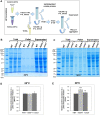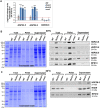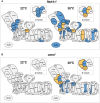FTSH4 and OMA1 mitochondrial proteases reduce moderate heat stress-induced protein aggregation
- PMID: 34608962
- PMCID: PMC8491029
- DOI: 10.1093/plphys/kiab296
FTSH4 and OMA1 mitochondrial proteases reduce moderate heat stress-induced protein aggregation
Abstract
The threat of global warming makes uncovering mechanisms of plant tolerance to long-term moderate heat stress particularly important. We previously reported that Arabidopsis (Arabidopsis thaliana) plants lacking mitochondrial proteases FTSH4 or OMA1 suffer phenotypic changes under long-term stress of 30°C, while their growth at 22°C is not affected. Here we found that these morphological and developmental changes are associated with increased accumulation of insoluble mitochondrial protein aggregates that consist mainly of small heat-shock proteins (sHSPs). Greater accumulation of sHSPs in ftsh4 than oma1 corresponds with more severe phenotypic abnormalities. We showed that the proteolytic activity of FTSH4, and to a lesser extent of OMA1, as well as the chaperone function of FTSH4, is crucial for protecting mitochondrial proteins against aggregation. We demonstrated that HSP23.6 and NADH dehydrogenase subunit 9 present in aggregates are proteolytic substrates of FTSH4, and this form of HSP23.6 is also a substrate of OMA1 protease. In addition, we found that the activity of FTSH4 plays an important role during recovery from elevated to optimal temperatures. Isobaric tags for relative and absolute quantification (iTRAQ)-based proteomic analyses, along with identification of aggregation-prone proteins, implicated mitochondrial pathways affected by protein aggregation (e.g. assembly of complex I) and revealed that the mitochondrial proteomes of ftsh4 and oma1 plants are similarly adapted to long-term moderate heat stress. Overall, our data indicate that both FTSH4 and OMA1 increase the tolerance of plants to long-term moderate heat stress by reducing detergent-tolerant mitochondrial protein aggregation.
© The Author(s) 2021. Published by Oxford University Press on behalf of American Society of Plant Biologists.
Figures








Similar articles
-
Lack of FTSH4 Protease Affects Protein Carbonylation, Mitochondrial Morphology, and Phospholipid Content in Mitochondria of Arabidopsis: New Insights into a Complex Interplay.Plant Physiol. 2016 Aug;171(4):2516-35. doi: 10.1104/pp.16.00370. Epub 2016 Jun 13. Plant Physiol. 2016. PMID: 27297677 Free PMC article.
-
The Arabidopsis Mitochondrial Protease FtSH4 Is Involved in Leaf Senescence via Regulation of WRKY-Dependent Salicylic Acid Accumulation and Signaling.Plant Physiol. 2017 Apr;173(4):2294-2307. doi: 10.1104/pp.16.00008. Epub 2017 Mar 1. Plant Physiol. 2017. PMID: 28250067 Free PMC article.
-
AtFtsH4 perturbs the mitochondrial respiratory chain complexes and auxin homeostasis in Arabidopsis.Plant Signal Behav. 2014;9(9):e29709. doi: 10.4161/psb.29709. Plant Signal Behav. 2014. PMID: 25763704 Free PMC article.
-
The lack of mitochondrial AtFtsH4 protease alters Arabidopsis leaf morphology at the late stage of rosette development under short-day photoperiod.Plant J. 2009 Sep;59(5):685-99. doi: 10.1111/j.1365-313X.2009.03907.x. Epub 2009 Jun 5. Plant J. 2009. PMID: 19453455
-
Mitochondrial metallopeptidase OMA1 in cancer.Adv Cancer Res. 2024;162:75-97. doi: 10.1016/bs.acr.2024.05.001. Epub 2024 May 22. Adv Cancer Res. 2024. PMID: 39069370 Review.
Cited by
-
The Role of FtsH Complexes in the Response to Abiotic Stress in Cyanobacteria.Plant Cell Physiol. 2024 Jul 30;65(7):1103-1114. doi: 10.1093/pcp/pcae042. Plant Cell Physiol. 2024. PMID: 38619128 Free PMC article. Review.
-
Protein Processing in Plant Mitochondria Compared to Yeast and Mammals.Front Plant Sci. 2022 Feb 2;13:824080. doi: 10.3389/fpls.2022.824080. eCollection 2022. Front Plant Sci. 2022. PMID: 35185991 Free PMC article. Review.
-
ROS inhibits microtubule dynamics and cell growth heterogeneity during Arabidopsis sepal morphogenesis.bioRxiv [Preprint]. 2025 May 14:2025.05.09.653143. doi: 10.1101/2025.05.09.653143. bioRxiv. 2025. PMID: 40463180 Free PMC article. Preprint.
-
The lowdown on breakdown: Open questions in plant proteolysis.Plant Cell. 2024 Sep 3;36(9):2931-2975. doi: 10.1093/plcell/koae193. Plant Cell. 2024. PMID: 38980154 Free PMC article. Review.
-
Robust organ size in Arabidopsis is primarily governed by cell growth rather than cell division patterns.bioRxiv [Preprint]. 2023 Nov 20:2023.11.11.566685. doi: 10.1101/2023.11.11.566685. bioRxiv. 2023. Update in: Development. 2024 Oct 1;151(19):dev202531. doi: 10.1242/dev.202531. PMID: 38014347 Free PMC article. Updated. Preprint.
References
-
- Balchin D, Hayer-Hartl M, Hartl FU (2016) In vivo aspects of protein folding and quality control. Science 353: aac4354. - PubMed
-
- Broquet AH, Thomas G, Masliah J, Trugnan G, Bachelet M (2003) Expression of the molecular chaperone Hsp70 in detergent-resistant microdomains correlates with its membrane delivery and release. J Biol Chem 278: 21601–21606 - PubMed
Publication types
MeSH terms
Substances
LinkOut - more resources
Full Text Sources
Molecular Biology Databases

